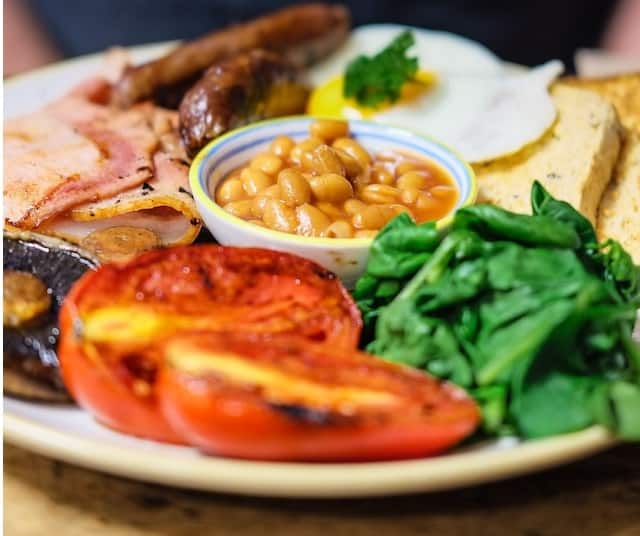Often on a daily basis, we don’t stop to think how much history there is in each of our meals. Ingredients, habits, schedules… our food is the result of countless social and economic factors.
In this blog post we will understand how the classic English breakfast, one of the most traditional English foods, became what it is today: A beloved culinary legacy that has become a quintessential part of British heritage.
With its hearty combination of eggs, bacon, sausages, baked beans, tomatoes, mushrooms, and toast, it’s a breakfast fit for champions. But have you ever wondered about the origins of this iconic meal?? Without further ado… let’s go!
The Breakfast Revolution

The concept of a substantial morning meal has a long history, dating back to ancient civilizations. However, it wasn’t until the 19th century that the modern idea of breakfast as we know it began to take shape in Britain. Previously, breakfasts were modest and primarily consisted of bread, porridge, or leftovers from the previous day’s dinner. Not super amazing, right? The emergence of the full English breakfast marked a shift in breakfast culture, providing a more substantial and indulgent start to the day.
A Working-Class Heritage

The full English breakfast can trace its roots to the working-class communities of the Industrial Revolution. In the factories and mines, workers needed a substantial meal to fuel their physically demanding labor. This led to the creation of a breakfast spread that provided a combination of protein, fat, and carbohydrates to sustain them throughout the day. All over the world we can find popular meals that started in the poorest social strata. Like the English breakfast, which started with the working class, or the classic Brazilian feijoada, which started with the slaves brought from Africa. The examples are countless.
The Rise of Bacon and Eggs: A Flavorful Addition

The inclusion of bacon and eggs in the full English breakfast can be attributed to changes in farming practices and cultural influences. Bacon gained popularity due to its rich, smoky flavor and versatility in various dishes. Eggs, affordable and protein-rich, became a common ingredient in working-class diets. All you had to do to have fresh eggs every day… was to raise a chicken! Cultural influences, such as Native American smoking techniques and American breakfast habits, further solidified the presence of bacon and eggs. This pairing created a harmonious blend of salty and smoky flavors with creamy and delicate textures, becoming a defining feature of the full English breakfast that is cherished to this day.
Sausages and Baked Beans: Additions to the Plate

Sausages have long been a part of British cuisine, finding their way into the English breakfast over time. Originally made with minced meat, herbs, and spices, sausages were a practical way to utilize and preserve meat. Regional variations like Cumberland and Lincolnshire sausages eventually made their mark on the breakfast plate.
Baked beans, with their tomato-based sauce, were introduced in the late 19th century. Canned baked beans became popular thanks to their convenience and affordability. American soldiers stationed in Britain during World War II further popularized baked beans in the English breakfast. Today, sausages and baked beans have become integral components of the traditional English breakfast, offering a flavorful and satisfying experience. But these ingredients are not exclusive to the British, being present in the meals of people all over the world since very remote times!
The Role of Regional Variations

While the core components of the full English breakfast remain consistent, there are regional variations across the country. In different parts of England, you may find additional items like black pudding, fried bread, or hash browns included in the spread. These regional variations add a unique touch to the traditional breakfast and reflect the local culinary traditions and preferences. Who would have thought that one meal could represent so many cultures? A plate of food, if looked at correctly, is actually a great history museum!
Accompaniments: Tomatoes and Mushrooms
Tomatoes and mushrooms made their way onto the full English breakfast plate in the early 20th century. The more popular a dish becomes, and the more it travels across the borders of the world, the more it receives influences from other cultures and other tastes. As the popularity of the breakfast spread grew, people started incorporating additional ingredients to enhance the flavors and add variety to the meal. Tomatoes, known for their vibrant color and tangy taste, were introduced as a grilled or sautéed accompaniment. Mushrooms, with their earthy flavor, were also included to provide an extra savory element. These additions not only brought freshness and depth to the breakfast but also added visual appeal to the plate.
Toast: A Timeless Tradition

Toast has been an integral part of the full English breakfast for generations, steeped in historical significance. Dating back to the 17th century, toast was originally made by placing bread slices on long forks and toasting them over an open flame. This early method led to the creation of the term “toasting” when offering a drink in celebration or honor. Over time, toasting evolved into the practice of browning bread slices using toasting racks or dedicated toasters. Today, toast remains a cherished component of the full English breakfast, preserving the rich traditions and flavors that have delighted generations of breakfast lovers.
If you are a British traditions fan, we recommend you to check our blog post with a curated list of “London’s Best Tea Spots” or maybe our article called “British Wine And English Wine – Cutting Through The Confusion”.
The Full English Breakfast Today

Despite changes in dietary habits and the rise of healthier breakfast alternatives, the full English breakfast continues to hold a special place in the hearts of many.
It has become a cultural icon, associated with lazy Sunday mornings, weekend brunches, and hotels offering a traditional English experience. It is often enjoyed as a treat or indulgence, a nostalgic reminder of the past and a celebration of British culinary heritage.
Full English Breakfast Beyond Borders
The full English breakfast has also transcended its British origins and gained popularity beyond the country’s borders. It has become a favorite among tourists visiting the UK, who seek to immerse themselves in the local culture and traditions. Furthermore, variations of the full English breakfast can be found in other countries, with similar breakfast spreads being offered in Ireland (as an Irish breakfast), Australia (as a big breakfast), and even in American diners.
A Delicious Tradition to Savor
In conclusion, the full English breakfast is more than just a meal; it’s a cultural institution. Its origins can be traced back to the working-class communities of the Industrial Revolution, who needed a hearty start to their day. Today, it remains a beloved culinary tradition, representing the rich heritage and indulgent spirit of British cuisine. So, the next time you sit down to enjoy a plate of eggs, bacon, sausages, and all the trimmings, remember the fascinating history and heritage behind this iconic breakfast feast!
Did you enjoy this content?! If so, make sure check our article “What Do You Find In A French Bakery” for more breakfast global exploration!

